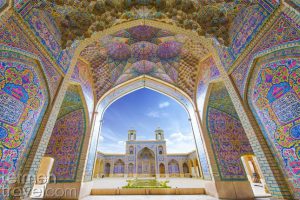The Phoenix immerses itself in flames and rises from the ashes elegantly. This is the story of Shahr-e Sukhteh or the burnt city that is located in the south-east of Iran. Although, unlike the popular opinion, the city did not literally burn, there is a reason behind its name that makes us picture a phoenix in mind and call it this way. a reason that shows the glory of Persia and the significance of this city in particular. But why was Shahr-e Sukhteh called this way in the first place?
Table of Contents
The Story Behind the Burnt City
The history of Shahr-e Sukhteh goes back to thousands of years before Christ, during the Bronze Age. One of the main documents that we have about this city comes from the Qajar Dynasty. An English colonel who was in Iran during that period of time went to Shahr-e Sukhteh and saw many piles of ash all around the area that were the result of manufacturing, so he called the place Shahr-e Sukhteh in his diary.
Until this day, no one knows the real name of this city; however, archeologists found some Sumerian inscriptions that talk about a city in that area called Arta. But there is an ongoing argument regarding the real name of the burnt city.
Why is Shahr-e Sukhteh Important?
You have definitely heard of people and even scientists who claim that many historical places on earth are built by aliens, not humans. If we have this idea in the corner of our mind, by reading about Shahr-e Sukhteh, we will consider the possibility of it. Shahr-e Sukhteh is way more complex and close to what we know as modern than the majority of cities in the world.
During the Bronze Age, there was a trading route that crossed the Iranian Plateau and passed Shahr-e Sukhteh on its way. The city was founded in 3200 BC, and as the archaeologists who were working on the area claim, there is a trace of the early civilization and complex societies in the East of Iran.
Italian archaeologists who were working on Shahr-e Sukhteh in the early 1900s could prove that this city gathered many people and built a society based on complex economic communication. Although there were some problems regarding food and safety that forced people to leave their homes behind and immigrate to another place, Shahr-e Sukhteh could provide a stable home for its people.
Being a place for trading artifacts and shipping them to other places in the world, having an enhanced economy and a developed society made Shahr-e Sukhteh significant for not only Iranians but also everyone who cares about history.
Archaeologists had major discoveries in the city. They found the first animation and artificial eye in Shahr-e Sukhteh, as well as one of the very first piping systems in the world and also evidence of skull surgery. Therefore, in 2014, this city was listed as one of UNESCO Heritage Sites to show its value.
All You Need to Know about Shahr-e Sukhteh Animation
When it comes to animation, the first picture that comes to mind is Disney’s animated movies, like Mickey Mouse, because animation is such a new concept. But, the first animation was found in Shahr-e Sukhteh of Iran. The credit for finding the animation goes to Italian archaeologists. But even the archaeologists probably did not have a clear understanding of what they have found. The 5200 years old pottery bowl is the animation that we are talking about. The bowl is designed with animals, probably goats.
Imagine the archaeologist who found the bowl, spun it, and was surprised to see the goat moving on the pottery!
Having a moving goat on the bowl and seeing it move is not just a coincidence. The creator of this masterpiece was so intelligent and creative that he/she designed the goat in a way that jumps up and eats the leaf in front of it with each spin.
Archaeologists still have some doubts about the meaning behind this bowl. The shape of the goat convinced them to relate this piece to Assyrian Dynasty and explain that the goat is eating the tree of life, which is a concept mostly found in the Assyrian culture. Later on, they realized that the bowl was made before the Assyrian period.
If you are eager to see the first animation in the world, you can apply for a visa and travel to Iran to find it in The Museum of Ancient Iran located in Tehran.
Shahr-e Sukhteh and The Artificial Eye
The first animation is not the only important discovery found in Shahr-e Sukhteh. In 2006, a group of archaeologists who were excavating ancient tombs in Shahr-e Sukhteh discovered the skeletons of a woman who had an artificial eyeball in her skull. Later research on this eyeball proved that Iranians used some animal oil and a cover of gold to make it. As the research shows, there were some gold lines on the eyeball to make it as authentic as possible.
While discovering this artificial eyeball, the archaeologists found out that the woman who owned it was actually 182 cm (6 feet) tall. Her height is more than the average height of women in her time, which is quite interesting.
What Are Other Findings in Shahr-e Sukhteh?

Another major discovery in Shahr-e Sukhteh is the different pieces of jewelry that archaeologists could find. This jewelry shows that the concept of fashion was popular in ancient Iran. Some of these pieces of jewelry are gold, and others are made of precious stones.
Also, the fabrics that are found in Shahr-e Sukhteh show that Iranians were some of the first people who invented the weaving system and could create fabrics. Also, in 2015, Iranian archaeologists found a piece of leather that was designed with some drawings which go back to the Bronze Age in this city.
Iran is full of unique places that can take you on a journey to see the trace of the human being in history and its discoveries. You can always apply for an Iran Visa or book a tour to visit these extraordinary places.










Leave a Comment